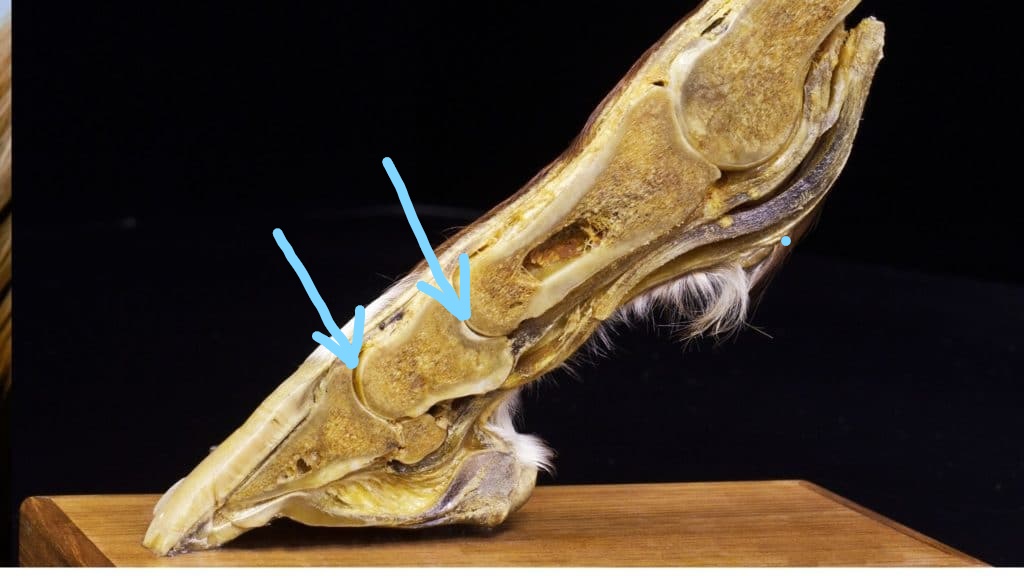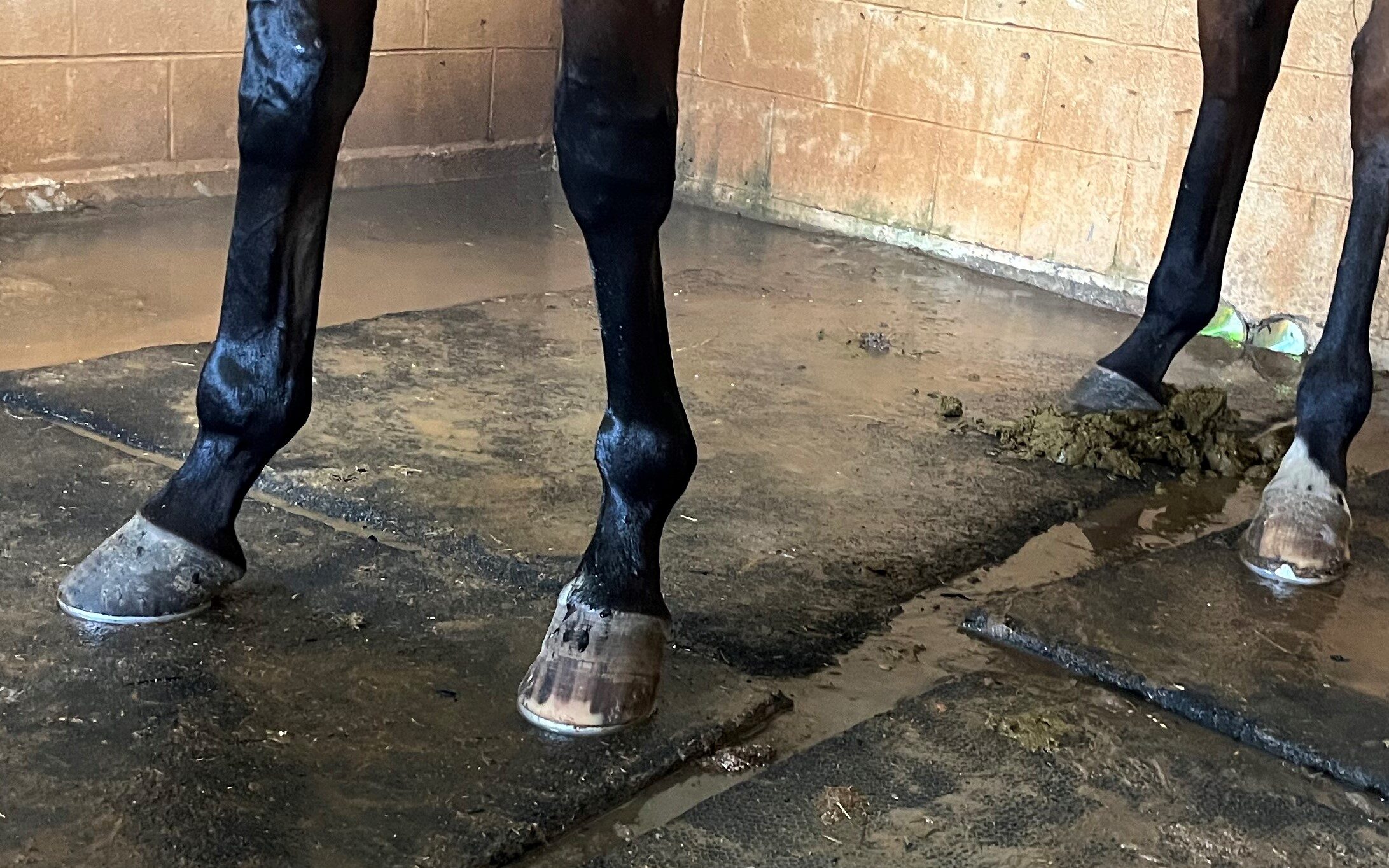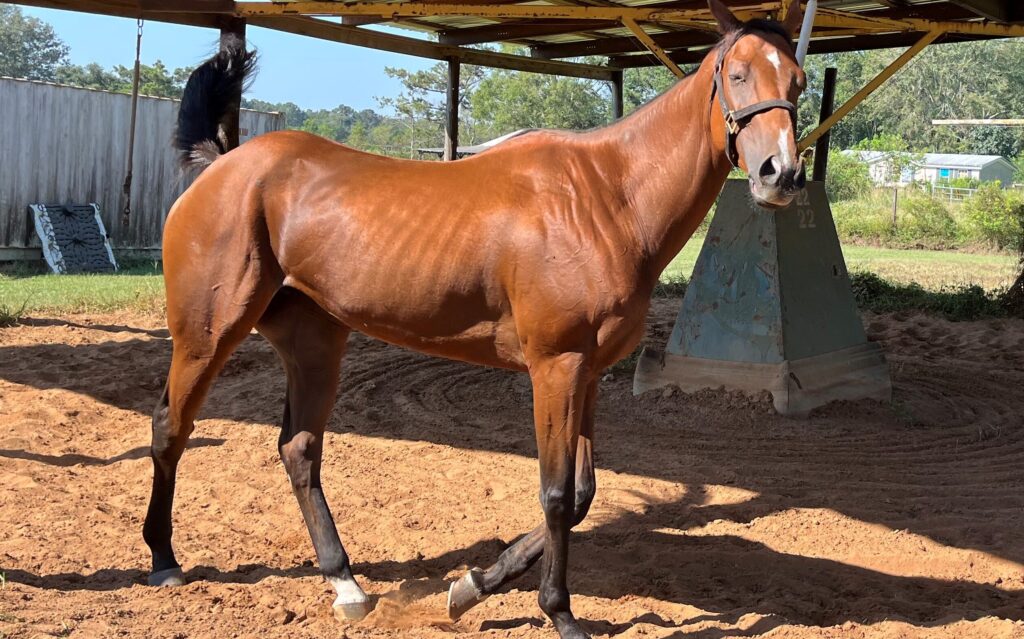Last updated: November 29, 2022
Any links on this page that lead to products on Amazon are affiliate links and I earn a commission if you make a purchase. Thanks in advance – I really appreciate it!
I was checking my horse’s legs and noticed heat near the top of its hoof. The trainer saw what I was doing and noticed the concern on my face. He told me the horse may have ringbone, and has a vet scheduled to come out.
Ringbone is a condition that can affect a horse’s joints. It causes pain, stiffness, and lameness in the affected area. The cause behind this bone disease isn’t clear yet, but some think it could be from repeated concussions, overuse, or conformation flaws. Early diagnosis and treatment are key to limiting the progression of this condition.
Ringbone is a serious condition that can cause a lot of pain for horses, so I was worried. In this blog post, we’ll take a look at what ringbone is, what causes it, and how it’s treated. So keep reading to learn more!

high ringbone
Low ringbone
What is ringbone?
Ringbone is a type of bone disease caused by abnormal growth of bone tissue in the pastern or coffin joints, leading to pain and joint instability. The name “ringbone” comes from the appearance of the affected bone, which often looks like they have a series of rings around them.
The type of ringbone is determined by its location. If the ringbone is in the pastern joint, it is referred to as a “high ringbone’, and if found in the coffin joint, then it’s called a “low ringbone.” Low ringbone occurs inside the hoof and most commonly affects horses’ front hooves but can also occur in their back hooves.
In addition, ringbone is more common in older horses that are used for strenuous activities, such as racing or jumping. However, a young horse can also develop ringbone disease.
What causes ringbone in horses?
There are many causes of ringbone in horses, but the most common is damage to the cartilage that cushions the bones at the joints. This damage can be caused by injuries, such as a kick from another horse, or overuse, such as when a horse is worked too hard or jumps too often.
Horses with upright pasterns or toed-in conformation are more prone to suffer from this disease, as do those that undergo repetitive stress in the pastern region, such as jumpers, barrel horses, and polo ponies. In addition, acute trauma in the pastern region can also predispose a horse to develop ringbone.
Other causes of ringbone include infection, arthritis, and tumors. Ringbone can cause severe lameness in horses and lead to early retirement or euthanasia.
What are the symptoms of ringbone?
Ringbone is a frustrating condition that can cause your horse a great deal of pain and difficulty moving. While ringbone can occur in any horse, it is most commonly seen in older animals.
There are several different symptoms that may indicate ringbone, depending on the severity of the condition, so it is important to be aware of what to look for. However, it’s common for horses with ringbone to short-stride and stumble.
In mild cases, ringbone may cause a dull ache or stiffness in the affected joint. The joint may also be swollen or warm to the touch. More severe cases of ringbone can cause lameness and joint deformity.
You can often see bone growth on the pastern bone in “high ringbone” cases. However, in ‘low ringbone,’ the bone growth is inside the hoof capsule and not typically visible. But you can feel the heat in your horse’s hoof and may notice swelling.
Ringbone is an arthritic, degenerative disease. If you think your horse has ringbone, it is important to see a veterinarian for a diagnosis. Early treatment is often the most effective way to manage the symptoms of ringbone.

Are there other conditions that cause similar symptoms to ringbone in horses?
Ringbone is a condition that results in the formation of bony growths on the horses’ bones. The symptoms of ringbone include pain and lameness. While ringbone is the most common cause of these symptoms, there are other conditions that can cause similar symptoms.
For example, arthritis can also lead to pain and lameness in horses. Arthritis is caused by the inflammation of the joints, which can occur for a variety of reasons. In some cases, arthritis may be the result of an injury. In other cases, it may be due to an underlying medical condition.
Regardless of the cause, arthritis can be a very painful condition for horses. Another condition that can cause similar symptoms to ringbone is laminitis (founder). The most common symptoms of founder in horses are pain, inflammation, and swelling in the hooves.
The horse may be reluctant to walk, limp, or show extreme discomfort. In severe cases, the horse may be unable to stand and will be found lying down.
Ligament damage can be very painful for horses and can lead to similar symptoms as ringbone. This condition is often caused by injuries, but it can also be the result of overuse or repetitive motion. Regardless of the cause, ligament damage can be very painful for horses and can lead to similar symptoms as ringbone.
Below is a YouTube video that provides a good explanation of ringbone.
What are the treatment options for a horse with ringbone?
Ringbone is a condition that affects horses’ hooves, causing the bones to grow abnormally. In severe cases, ringbone can be very painful and make it difficult for horses to walk. While there is no cure for ringbone, there are some things you can do.
- Rest
Rest is often the best thing for affected horses. By giving them a chance to rest and recover, you can help reduce their pain and improve their mobility. When you return to riding, alter his exercise and riding plan to reduce wear and tear on the joint.
- Weight control
It is also important to keep your horse at an appropriate body weight. Being overweight puts additional stress on their legs and feet, making the condition worse.
- Corrective shoeing
Trimming the horse’s hooves and providing supportive shoeing. can also be helpful when it comes to managing ringbone. A shoe that limits the torque on the joint is useful in this type of diagnosis.
- Joint supplements
Joint supplements provide nutrients that support healthy joint function. They can help to reduce inflammation and pain. In some cases, they may also help slow ringbone progression.
- Steroid injections
Intra-articular steroid injections may help to reduce inflammation and improve joint function. Injections are usually given every four to six weeks, and many horses show significant improvement after a few rounds of treatment. However, ringbone can be a chronic condition, and some horses may require ongoing treatment to maintain comfort.
- Anti-inflammatory medications.
While there is no cure for ringbone, anti-inflammatory medications may help to alleviate some of the pain and inflammation associated with the disease.
- Surgery
Surgery is an option that may be considered for horses with ringbone. The goal of surgery is to remove the bony growths and relieve pain. In some cases, the surgeon may also need to fuse together bones in order to stabilize the leg. While surgery is not a cure for ringbone, it can help improve the horse’s quality of life and make it easier for them to remain active.
How is ringbone in horses diagnosed?
A veterinarian will typically use a combination of clinical signs, medical history, and diagnostic imaging to diagnose ringbone in horses. Clinical signs can include lameness, stiffness, and decreased range of motion in the joint.
The medical history may reveal that the horse has been treated for chronic soreness or stiffness in the pastern or coffin joint region. Diagnostic imaging can include radiographs (x-rays) and/or magnetic resonance imaging (MRI).
Radiographs are commonly used to diagnose ringbone and can reveal changes in the bones around the affected joint, such as swelling, enlargement, or boney proliferation. MRI is often used to assess soft tissue damage around the joint.

How can you prevent ringbone from happening to your horse?
Ringbone is a condition that affects the bones and joints in a horse’s legs. It is caused by the overgrowth of new bone tissue, which can be painful and cause lameness. Ringbone is most commonly seen in older horses but can also occur in younger animals if they experience an injury to the affected area. There are several ways to prevent ringbone from developing, including:
- Keep your horse’s feet healthy and well-trimmed. This helps to ensure that the bones and ligaments are not under excessive strain and avoid any pressure points that could lead to ringbone.
- Use proper farrier techniques when shoeing your horse. This will help to distribute the weight evenly and prevent any undue stress on the joints.
- Be aware of any injuries or soreness in your horse’s legs. prompt treatment can help to prevent the development of ringbone.
- Ice your horse’s legs after strenuous exercise; this will help keep inflammation at bay and help to prevent bone growth that leads to ringbone.
- Finally, it is important to provide the horse with plenty of exercise and a balanced diet, as this will help to keep the bones and ligaments strong and your horse at a healthy weight.
Following these simple guidelines can help keep your horse healthy and free from this painful condition.
Are there any alternative therapies that can help treat ringbone?
Some horse owners have had success using complementary and alternative therapies, such as chiropractic care or acupuncture. Chiropractic care involves manipulating the bones and joints to improve alignment and relieve pressure on the nerves.
Acupuncture involves inserting needles into specific points on the body to stimulate healing. There is limited scientific evidence to support the use of these therapies for ringbone, but some horse owners report that they have helped to improve their horse’s condition. Talk to your veterinarian about whether these therapies might be right for your horse.
What are the chances of a horse recovering from ringbone?
Some horses with ringbone may return to competition with the proper treatment, while others may not be as fortunate. A number of factors can influence how well a horse responds to treatment, including the severity of the condition, the cause of the ringbone, and how early it is detected and treated.
Also the location of the injury plays a role in recovery. High ringbone in the horse’s hind legs seems to do better after fusion surgery than the front legs. However, remember that ringbone is a degenerative disease that never fully heals.
If you suspect that your horse may have ringbone, it is important to take him or her to a veterinarian for an accurate diagnosis and treatment plan. With early detection and appropriate care, many horses with ringbone can go on to lead happy and productive lives.
What should you do if you suspect that your horse has ringbone?
If you suspect that your horse has ringbone, you should take it to a veterinarian for an examination. The veterinarian will perform a physical examination and may order x-rays to determine if your horse has ringbone. Treatment for ringbone may include rest, medications, or surgery.
Here are several things you can do if you suspect your horse has ringbone before it’s confirmed by your veterinarian:
- Provide comfortable, supportive footing in your stable – wood shaving or straw bedding are good options.
- If your horse is lame, provide stall rest until he is sound again.
- Give your horse anti-inflammatories.
Conclusion
Ringbone is a condition that affects the horse’s pastern and cannon joints, and it can be very painful. The symptoms of ringbone include stiffness in the joint, swelling, and lameness. There are several possible causes of ringbone, including injury, overuse, or arthritis.
And although there are no known cures for ringbone, treatments available can help reduce inflammation and pain; these include rest, steroid injections, anti-inflammatory meds, or surgery.
For horses that are predisposed to developing ringbone you can reduce their risk by taking certain precautions, such as keeping them at a healthy weight, keeping their feet cared for, icing their legs after strenuous activities, and reducing their work load.
If you suspect that your horse has ringbone, you should take him to a veterinarian for diagnosis and treatment. Other conditions that can cause similar symptoms to ringbone include navicular disease and laminitis.
FAQs
Can you ride a horse with ringbone?
Yes, you can ride a horse with a minor case of “high ringbone.” However, check with your veterinarian, because, in most instances, your horses shouldn’t be ridden if it has ringbone.
Can you cure ringbone in your horse?
No, there is no cure for ringbone. However, there are treatments available that can help to minimize its effects. These treatments include corrective shoeing, anti-inflammatory drugs, steroid injections, and surgery.
Is high or low ringbone worse?
There is no definitive answer to this question as it depends on the individual case. However, generally speaking, low ringbone is worse as it can be harder to detect and can progress more rapidly.

About the Author: Miles Henry
Lifelong Horseman | Racehorse Owner | Published Author
Miles Henry brings over 25 years of hands-on experience training and owning Thoroughbred racehorses. Raised with Quarter Horses and Appaloosas, he’s spent a lifetime learning from horses—on the track, in the barn, and in the field. Today, he runs a small but successful racing stable in Louisiana and shares real-world insights on HorseRacingSense.com, helping horse owners, fans, and bettors navigate the sport with confidence.
📚 Books: View Miles’s books on Amazon »
🎧 Podcast Guest: Animal Tales Ep. 32 |
YouTube Interview
📩 Newsletter: Sign up for racing tips and horse care advice »
🔗 Follow Miles:
Twitter |
Facebook |
YouTube


